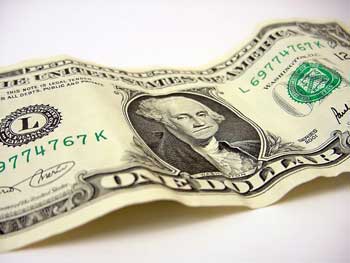Physics in Your Wallet: Move your Money Maker with Magnets

When payday rolls around and you’re wondering what to do with your money, try this simple experiment and make your money move!
What you Need
- A dollar bill (a five, ten, or twenty dollar bill will also work
- A strong magnet (neodymium magnets work best)
What to Do
- Take the magnet and hold it above an area on the dollar bill where there is a lot of ink (the president’s lapel or jacket is a great location).
- Bring the magnet to the point where it is touching the president’s jacket or lapel and then slowly move the magnet back.
- Observe the dollar bill. Did you see any movement?
- Repeat.
What’s Going On?
When the US Federal Reserve prints money, they use ink that contains iron oxide or other particles, which are magnetized. Besides being useful for the physics trick above, this technology is often used in vending machines, equipped with special equipment able to recognize different magnetic patterns of different denominations. The special equipment belongs to a class of scanning technology called Magnetic Ink Character Recognition (MICR) technology.
This still does not explain exactly why the bill is attracted to the magnet. First it is important to understand how magnets work. Magnets have two sides or poles, a north pole and a south pole, often referred to as the negative and the positive poles, respectively. The reason that magnets have two distinct poles is due to the orientation of the molecules that make up the magnet. When the molecules align in a way so that all the positive poles are facing one direction and all the negative poles are facing the other direction, it is a magnet. Imagine a marching band that is running onto a field from all directions. There doesn’t appear to be any order and people are facing every direction. However, when the band stops and faces the crowd, their faces are facing in the same direction and their backs are facing the other. The marching band members are like the molecules, when they aren’t facing the same direction they aren’t magnetized, but as soon as they face the same direction, they would become a magnet.
When two magnets are put together they will repel each other if the poles of each magnet are the same. In order for a magnet to be attracted to another magnet the opposite poles need to be facing each other. For example, the negative pole should be facing the positive pole in order for them to attract.
That explains how magnets work, but why does the iron oxide in a dollar bill attract to a magnet. The answer is quite simple. Under the right circumstances iron oxide can act like a magnet. When one side of the magnet is put in contact with iron oxide, the magnet induces, or causes, the iron oxide to act like it is a magnet. Remember the marching band? If you think about the marching band as being the iron oxide molecules in the ink of the dollar bill. Then try to imagine a large magnet that comes and plops itself down on the bleachers. When there is no magnet the marching band members can face any direction they want, but when the magnet appears, they would all face the magnet This is what happens with the iron oxide molecules, in essence the molecules orient themselves so that the particles in each molecule that is attracted to the magnet would face or become closest to the magnet. This explains why the ink that contains iron oxide is attracted to the magnet.
Try This!
- Does it work the same with a five dollar bill, ten dollar bill, or twenty dollar bill?
- Try moving the magnet around the dollar bill; are there areas that work better than others?
More Information











